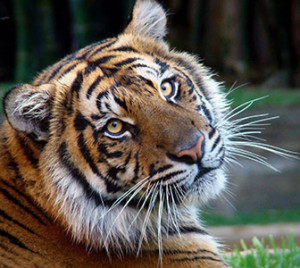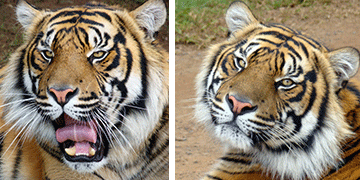Coronavirus pandemic could trigger happy ending for tigers
What happened after the book ended? Did China finally bend to international will and stop farming tigers, rhinos, and bears like cows and pigs? Readers still write to ask me five years after Beacon Press published Blood of the Tiger: A Story of Conspiracy, Greed, and the Battle to Save a Magnificent Species. My answer, as of this moment—when COVID-19 has shut down much of the world—is this: You can watch the rest of the story unfold in real time.
As I write, President Donald Trump has blamed China for not stopping the spread of COVID-19, renaming it the “China virus” and provoking racist assaults on Asian Americans. Chinese authorities have suggested that a member of the US military brought the virus to the disease’s epicenter in the city of Wuhan. Politicians and conservation organizations are pointing the finger at teeming “wet markets” across Asia, where all manner of wildlife is dragged from forests and kept in squalid conditions before being butchered by sundry inhumane and unsanitary means. If there ever were a petri dish for spawning emerging diseases, these markets fit the bill.
Scientists have concluded that COVID-19 was not manmade in a laboratory. Rather, the virus somehow jumped from animals to humans, who spread it worldwide. Much like the scenario in the 2012 Hollywood movie Contagion, which many homebound people are watching in astonishment and horror these days.
Researchers surmise that the 2003 SARS coronavirus may have originated from bats infecting civets, a favorite bush meat cuisine in China. They’ve pinned the 2012 MERS coronavirus on camels, perhaps in the Middle East. Scientists haven’t pinpointed the exact origin of the Ebola virus, but they suspect bats and non-human primates in the Democratic Republic of Congo–yet another zoonotic transfer of disease from animals to humans. Scientists speculate the 1918 flu pandemic that killed some 50 million people worldwide jumped from birds to humans, perhaps originating in the United States. Seasonal flu viruses generally come from somewhere in Asia, sometimes linked to livestock.
“Historical data show that all pandemic influenza occurrences originated from animals,” according to the World Health Organization. The nonprofit organization Freeland recently launched a campaign urging people to “write to your government and ask them to ‘protect people and wildlife by banning wildlife trade as a matter of public health and environmental security in light of the COVID-19 pandemic.’”
In truth, no one can identify, beyond the shadow of a doubt, the genesis of COVID-19 at this time, although Chinese scientists confirmed it is a close relative of SARS. Nonetheless, faulting China has become a global meme. Chinese authorities, if only for the sake of the country’s self-preservation, have acted accordingly.
“The Standing Committee of the National People’s Congress, or China’s top legislature, during a session Monday adopted a decision on thoroughly banning the illegal trading of wildlife and eliminating the consumption of wild animals to safeguard people’s lives and health . . . including those that are bred or reared in captivity . . . ,” China’s official Xinhua news agency reported on February 24.
“There has been a growing concern among people over the consumption of wild animals and the hidden dangers it brings to public health security since the novel coronavirus disease (COVID-19) outbreak,” Zang Tiewei, spokesperson for the Commission of Legislative Affairs of the National People’s Congress, said after the ban was approved.
 Sounds promising for tigers, rhinos, bears, and other endangered wild animals now commercially farmed in China. But here’s the rub, as spelled out by Xinhua: “The decision also stipulates that the use of wild animals for non-edible purposes, including scientific research, medical use and display, shall be subject to strict examination, approval and quarantine inspection procedures in accordance with relevant regulations.” Tigers are farmed for their bones, rhinos for their horns, and bears for the bile in their gall bladders, all for use in traditional Chinese medicine. So, while wet markets in China may be closing, factory farms for endangered species appear to be carrying on as usual, despite the inherent disease risk.
Sounds promising for tigers, rhinos, bears, and other endangered wild animals now commercially farmed in China. But here’s the rub, as spelled out by Xinhua: “The decision also stipulates that the use of wild animals for non-edible purposes, including scientific research, medical use and display, shall be subject to strict examination, approval and quarantine inspection procedures in accordance with relevant regulations.” Tigers are farmed for their bones, rhinos for their horns, and bears for the bile in their gall bladders, all for use in traditional Chinese medicine. So, while wet markets in China may be closing, factory farms for endangered species appear to be carrying on as usual, despite the inherent disease risk.
Here’s the potentially good news, as I see it. This is the moment—perhaps the last, best moment—for the world to finally put an end to commercial wildlife farming promoted by China and growing across Southeast Asia, South Africa, and elsewhere. Farming that has raised demand for wildlife parts and products and put a price on the head of every tiger, rhino, and bear in the wild, because many consumers believe those taken from the wild are of superior quality—not unlike wild versus farmed salmon.
While China may or may not be the origin of the current pandemic, its people were hit hard by both SARS and COVID-19. “The COVID-19 pandemic has pushed the issue of wildlife trade into the global spotlight as a threat to our public health, global economy and security,” wrote Grace Ge Gabriel, regional director for Asia at the International Fund for Animal Welfare. “I am encouraged to see China step up to curtail wildlife trade. Breaking the petri dish that grows epidemics needs global coordination and vigorous enforcement along every link in the trade chain.”
Still, powerful political and economic interests, inside and outside the Chinese government, will push back on China’s new ban as soon as the immediate dangers of COVID-19 have passed, just as they did after similar moments of inflection detailed in Blood of the Tiger. They may already be doing so. The Environmental Investigation Agency (EIA) just reported that China’s National Health Commission is recommending a traditional medicine treatment for COVID-19 that contains bear bile. This brings to mind the insistence by Chinese wildlife authorities that tiger bone was essential for treating SARS.
“Restricting the eating of wildlife while promoting medicines containing wildlife parts exemplifies the mixed messages being sent by Chinese authorities on wildlife trade,” EIA China specialist Aron White said in a statement posted Monday.
Chinese wildlife authorities charged with regulating—and promoting—China’s wildlife farms balked at President Xi Jinping’s 2015 deal with President Barack Obama to end ivory trade. But Xi prevailed. I joined my fellow conservationists in hoping that Xi and Obama’s successor would broker similar agreements on ending all commercial trade in parts and products from tigers, rhinos, bears, and other endangered species coveted in Chinese medicines and prestige cuisine. Trump’s election dashed those hopes.
Now we have COVID-19, which has brought China’s commercial wildlife trade to the attention of billions of people around the world who are currently living in fear for their lives and livelihoods. If the world continues to blame China—rightly or wrongly—for spawning this health and economic crisis that spans the planet, Xi will have to demonstrate containment of his country’s breeding grounds for future pandemics. Permanently shuttering wet markets, bush meat restaurants, and massive wildlife farms would be one highly credible, verifiable way for China to regain the trust and good graces of the world.
